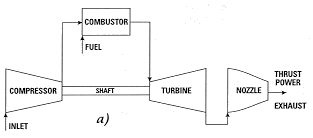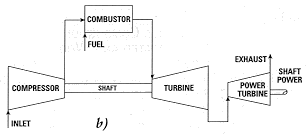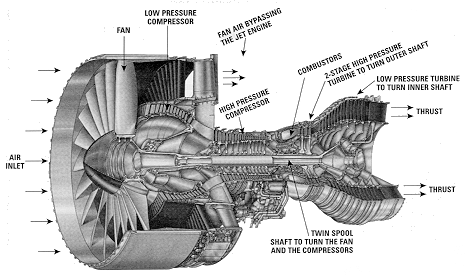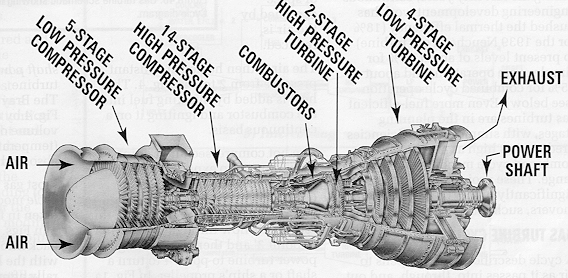 |
|||||
| Home | Research | For Teachers | HISTORY Level 1 Level 2 Level 3 |
PRINCIPLES Level 1 Level 2 Level 3 |
CAREER Level 1 Level 2 Level 3 |
| Gallery | Hot Links | What's New! | |||
| Web Administration and Tools | |||||
 |
|||||
| Home | Research | For Teachers | HISTORY Level 1 Level 2 Level 3 |
PRINCIPLES Level 1 Level 2 Level 3 |
CAREER Level 1 Level 2 Level 3 |
| Gallery | Hot Links | What's New! | |||
| Web Administration and Tools | |||||
Aircraft Propulsion - Level 3
![]()
In an aircraft gas turbine the output of the turbine is used to turn the compressor (which may also have an associated fan or propeller). The hot air flow leaving the turbine is than accelerated into the atmosphere through an exhaust nozzle (Fig. la) to provide thrust or propulsion power:

Figure 1a. Schematic for an aircraft jet engine

Figure 1.b A land-based gas turbine.
A typical jet engine is shown in Fig. 2. Such engines can range from about 100 pounds of thrust (lbst.) to as high as 100,000 lbst. with weights ranging from about 30 to 20,000 lbs. The smallest jets are used for devices such as the cruise missile, the largest for future generations of commercial aircraft. The jet engine of Fig.2 is a turbofan engine, with a large diameter compressor-mounted fan. Thrust is generated both by air passing through the fan (bypass air) and through the gas generator itself. With a large frontal area, the turbofan generates peak thrust at low (takeoff) speeds making it most suitable for commercial aircraft.

Figure 2. A modern jet engine used to power Boeing 777 aircraft.
This is a Pratt & Whitney PW4084 turbofan which can produce 84,000 pounds of thrust.
It has a 112-inch diameter front-mounted fan, a length of 192 inches (4.87 m) and a weight
of about 15,000 pounds (6804 kg). The nozzle has been disconnected from this engine.
A turbojet does not have a fan and generates all of its thrust from air that passes through the gas generator. Turbojets have smaller frontal areas and generate peak thrusts at high speeds, making them most suitable for fighter aircraft.
In non-aviation gas turbines, part of the turbine power is used to drive the compressor. The remainder, the "useful power", is used as output shaftpower to turn an energy conversion device (Fig. lb) such as an electrical generator or a ship's propeller.
A typical land-based gas turbine is shown in Fig. 3. Such units can range in power output from 0.05 MW(Megawatts) to as high as 240 MW. The unit shown in Fig. 3 is an aeroderivative gas turbine; i.e., a lighter weight unit derived from an aircraft jet engine. Heavier weight units designed specifically for land use are called industrial or frame machines. Although aeroderivative gas turbines are being increasingly used for base load electrical power generation they are most frequently used to drive compressors for natural gas pipelines, power ships and provide peaking and intermittent power for electric utility applications. Peaking power supplements a utility's normal steam turbine or hydroelectric power output during high demand periods ... such as the summer demand for air conditioning in many major cities.

Figure 3. A modern land-based gas turbine used for electrical power production and
for mechanical drives. This is a General Electric LM5000 machine with a length of 246
inches (6.2 m) and a weight of about 27,700 pounds (12,500 kg). It produces maximum shaft
power of 55.2 MW (74,000 hp) at 3,600 rpm with steam injection. This model shows a direct
drive configuration where the l.p. turbine drives both the l.p. compressor and the output
shaft. Other models can be made with a power turbine.
Some of the principle advantages of the gas turbine are:
It is capable of producing large amounts of useful power for a relatively small size and weight.
Since motion of all its major components involve pure rotation (i.e. no reciprocating motion as in a piston engine), its mechanical life is long and the corresponding maintenance cost is relatively low.
Although the gas turbine must be started by some external means (a small external motor or other source, such as another gas turbine), it can be brought up to full-load (peak output) conditions in minutes as contrasted to a steam turbine plant whose start up time is measured in hours.
A wide variety of fuels can be utilized. Natural gas is commonly used in land-based gas turbines while light distillate (kerosene-like) oils power aircraft gas turbines. Diesel oil or specially treated residual oils can also be used, as well as combustible gases derived from blast furnaces, refineries and the gasification of solid fuels such as coal, wood chips and bagasse.
The usual working fluid is atmospheric air. As a basic power supply, the
gas turbine requires no coolant (e.g. water).
In the past, one of the major disadvantages of the gas turbine was its lower efficiency (hence higher fuel usage) when compared to other IC engines and to steam turbine power plants. However, during the last fifty years, continuous engineering development work has pushed the thermal efficiency (18% for the 1939 Neuchatel gas turbine) to present levels of about 40% for simple cycle operation, and about 55% for combined cycle operation (see next section). Even more fuel-efficient gas turbines are in the planning stages, with simple cycle efficiencies predicted as high as 45-47% and combined cycle machines in the 60% range. These projected values are significantly higher than other prime movers, such as steam power plants.
The original article from which this section is extracted, Introduction to Gas Turbines for Non-Engineers, by Lee S. Langston, University of Connecticut and George Opdyke, Jr., Dykewood Enterprises, can be found in the ASME International Gas Turbine Institute's "Global Gas Turbine News", Volume 37, No.2, 1997, and has been used with permission.
Send all comments to ![]() aeromaster@eng.fiu.edu
aeromaster@eng.fiu.edu
© 1995-98 ALLSTAR Network. All rights reserved worldwide.
| Funded in part by | From ASME The International Gas Turbine Institute |
Updated: February 23, 1999